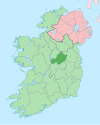
Ballymahon on the River Inny is a town in the southern part of County Longford, Ireland. It is located at the junction of the N55 National secondary road and the R392 regional road.

Mullingar is the county town of County Westmeath in Ireland. It is the third most populous town in the Midland Region, with a population of 22,667 in the 2022 census.

Castlepollard is a village in north County Westmeath, Republic of Ireland. It lies west of Lough Lene and northeast of Lough Derravaragh and Mullingar.

Kilbeggan is a town in County Westmeath, Ireland. It is in the barony of Moycashel.

Longford–Westmeath is a parliamentary constituency represented in Dáil Éireann, the lower house of the Irish parliament or Oireachtas. The constituency elects 4 deputies on the system of proportional representation by means of the single transferable vote (PR-STV).

The villages of Killucan and Rathwire are co-located in the east of County Westmeath, Ireland. They have a combined population of 1,370 according to the 2016 census. Killucan is on the R156 road about 15 km (9.3 mi) from Mullingar and 60 km (37 mi) from Dublin.

Collinstown is a village in north County Westmeath, situated on the R395 regional road overlooking Lough Lene. It lies 18 km (11 mi) northeast of the county town of Mullingar and had a population of 356.

Castletown Geoghegan is a village in County Westmeath, Ireland, and lies south west of Lough Ennell near the county town of Mullingar. It is around 13 km south-west of Mullingar and 19 km north of Tullamore. Castletown was the seat of the Geoghegan family of the medieval Barony of Moycashel in County Westmeath.

Ballymore is a village in County Westmeath, Ireland, on the R390 road between Athlone and Mullingar. The historic Hill of Uisneach is nearby. The village was known in medieval times as the medieval borough of Ballymore Lough Sewdy, or Loughsewdy, after the nearby lake, the site of an ancient bruighean, or hostel.

Newtown Forbes is a large village in County Longford, Ireland. It was historically called Lisbrack, an anglicisation of the Irish name.

Tristernagh Abbey, also known as the Priory of Kilbixy or Kilbisky, Tristernagh Priory, or the priory of the Blessed Virgin Mary of Tristernagh, is a ruined Augustinian monastery in the townland of Tristernagh in the barony of Kilbixy in County Westmeath, Ireland. It is situated on the shores of Lough Iron, about 3 kilometres (1.9 mi) north east of the village of Ballynacargy.

Moygoish is a barony in north County Westmeath, in Ireland, formed by 1672. It is bordered by County Longford to the west and four other Westmeath baronies: Corkaree, Fore, Moyashel and Magheradernon and Rathconrath to the south–west.

Moyashel and Magheradernon is a barony in the centre of County Westmeath, in Ireland, formed by 1672. It is bordered by eight other baronies: Corkaree and Fore, Delvin and Farbill, Fartullagh and Moycashel and Rathconrath and Moygoish.

Farbill is a barony in east County Westmeath, in Ireland. It was formed by 1672. It is bordered by County Meath to the south and east and three other baronies: Fartullagh, Moyashel and Magheradernon and Delvin. The largest centre of population in the barony is the town of Kinnegad.
Leny is a civil parish in County Westmeath, Ireland. It is located about 10.5 kilometres (7 mi) north–west of Mullingar. This name also applies to the townland of Leny; neither should be confused with the Falls of Leny in Scotland.
Templeoran is a civil parish in County Westmeath, Ireland. It is located about 8.4 kilometres (5 mi) north‑west of Mullingar.
Kilbixy is a civil parish in County Westmeath, Ireland. It is located about 13.25 kilometres (8 mi) north‑west of Mullingar. The village of Ballynacarrigy is the largest settlement in the parish.
Grange is a townland in County Westmeath, Ireland. It is located about 11.3 kilometres (7 mi) north–west of Mullingar.
Rathaspick is a civil parish in County Westmeath, Ireland. It is located about 18.17 kilometres (11 mi) north–west of Mullingar.
Piercetown is a civil parish in County Westmeath, Ireland. It is located about 18.69 kilometres (12 mi) west–north–west of Mullingar. It was formerly often spelled Pierstown.
















